AMD’s Radeon HD 5770 & 5750: DirectX 11 for the Mainstream Crowd
by Ryan Smith on October 13, 2009 12:00 AM EST- Posted in
- GPUs
Power, Temperature, & Noise
With the 5700 series being built using TSMC’s 40nm process, and with their low target power, we should see some interesting results here.
We do need to note however that thanks to some badly timed broken hardware, we’re using our secondary test rig for noise and temperature data, so the results are not directly comparable to our 5800 series reviews. As a result we also only have power data for the 5770; we weren’t able to get power data on the 5750 in time for this article.
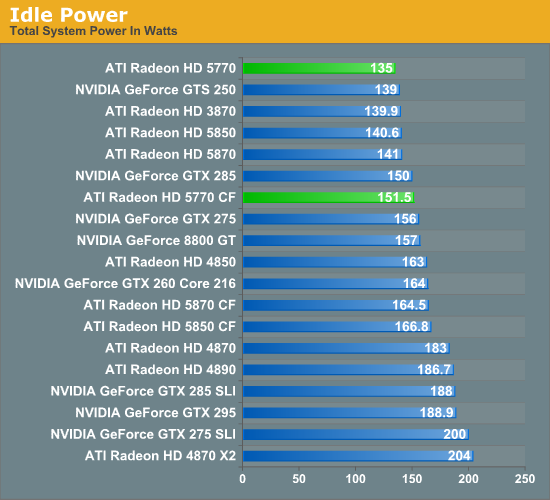
Thanks to the 40nm process and relatively simple nature of Juniper, the 5770 turns in the best idle power usage of all of our mainstream and high-end cards. At 135W it edges out the GTS 250, the 3870, and its bigger brothers the 5800 series. Coupled with a good CPU, and this should result in a system with very good idle power usage for the performance levels it provides.
We can also see the low power usage of an individual 5770 in our 5770 CF usage. There's a 16.5W difference, as the slave card gets to power down even further than 18W.

At 256W for load power, the 5770 isn’t quite the winner here like it is for idle power. The 3870 beats it by 14W at the cost of a significant degree of performance, while the 8800GT is neck-and-neck with the 4770, again with a decent-sized performance gap. Everything past here approaches 300W and beyond. As a result, even if it’s not the least power hungry card we have, it’s very close, and it’s certainly among the best for on a power-to-performance ratio.
Meanwhile looking at the Crossfire results, we see that there's a 134W difference between cards. As the Evergreen architecture allows us to go higher so long as the VRMs are safe, this appears to that situation in action.
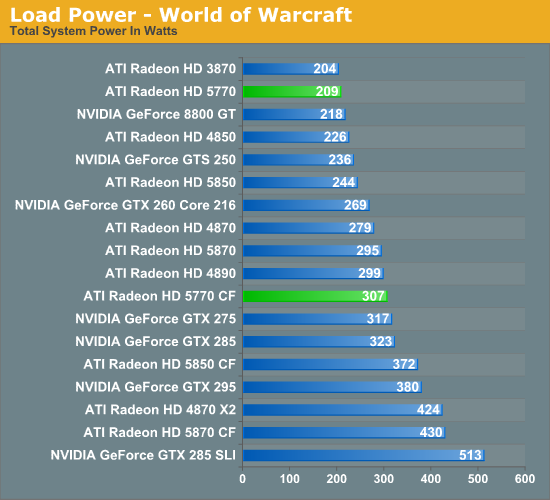
World of Warcraft gives us similar results. The 5770 still doesn’t come out on top, but its bested only by the 3870 and its significantly lower performance. The gap on the other side isn’t particularly large either, but the first card that can beat the 5770’s average gaming performance doesn’t show up until we hit the 5850.
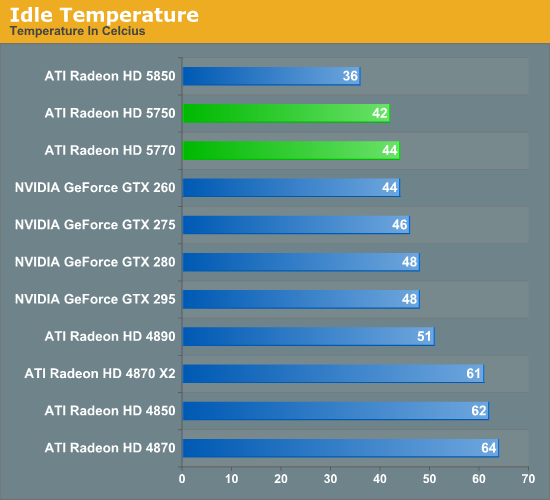
The 5700 series turns in some of our best idle temps, tying or beating everything besides a 5850. In fact we’re a bit surprised to see a 5850 win here given the lower idle power usage of the 5700 series, but the data doesn’t lie.
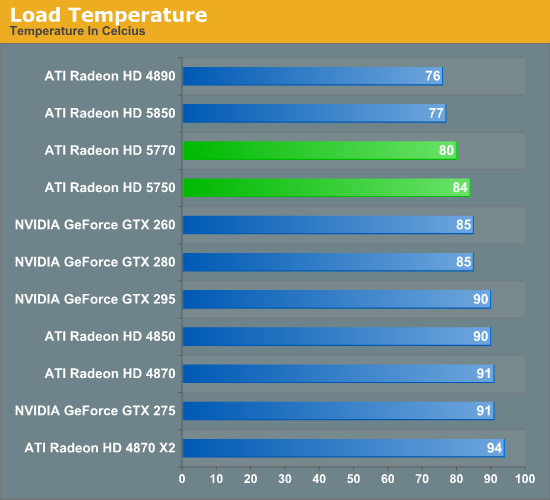
It’s load temperatures where all of the action is at. Again the 5700 series do quite well here, only losing to the 5850 and a very loud 4890. Compared to the rest of the 4800 series in particular, we’re a good 6C-11C cooler for a set of cards that offer similar to slightly less performance. Aren’t smaller manufacturing processes great?
However in spite of the 5750’s lower power consumption, it doesn’t do so well here in terms of temperature compared to the 5770, coming in 4C hotter. We’re going to chalk it up to the egg cooler being unable to match the 5770’s shrouded cooler. This of course makes the fact that the 5770’s shrouded cooler is going to eventually go away all the more meaningful, as conceivably the replacement coolers would end up being less effective.
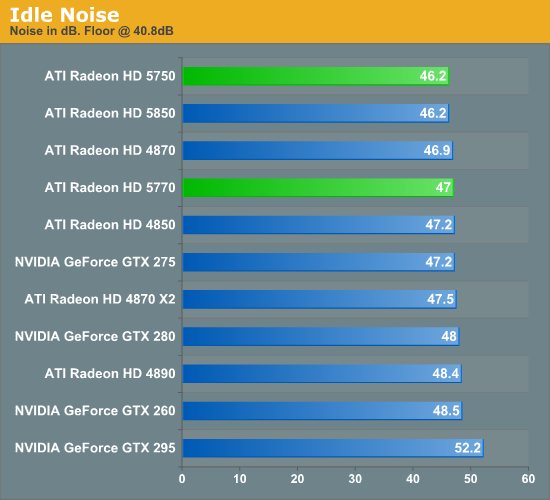
As is the case for most of the cards we test, at idle they’re virtually all the same. The 5700 series are no exception to this rule.
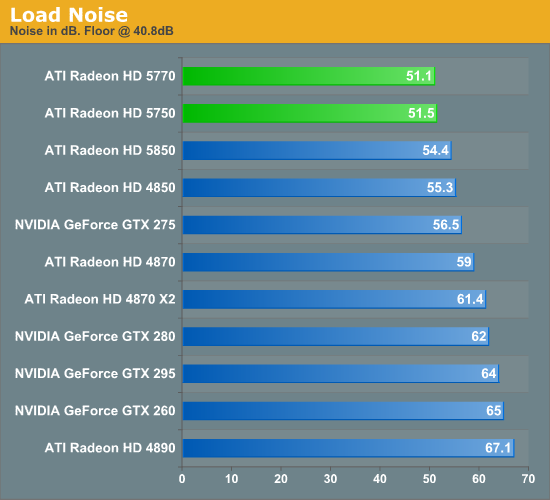
With the low power consumption of the 5700 series, their coolers don’t have to work very hard to reach their already low load temperatures. At 51dB, these are the quietest cards we’ve tested at this level of performance; we would need to drop down to something slower yet (like yesterday’s GT 220) to find something quieter.
We also can’t rule out the possibility of the 5750 going passive in the future, given its already dainty cooler. We’ve seen it done before on an 8800GT, which has a similar thermal envelope. This certainly has all the makings of the fastest passively cooled card on the market, if someone can build the right cooler.
This also leaves the door open to the idea of using the 5750 as an HTPC card. With bitstreaming audio support it’s the best HTPC card we’ve tested yet from a features standpoint, but we’re not convinced that it’s going to be the best thing out there given it’s >$100 price tag and the fact that it’s still power-hungry enough to need a PCIe power connector. In the long-term the 5600 series may be a better replacement given the same features and lower power consumption that a lower-performing part will offer, but that’s something we won’t be able to test until next year.










117 Comments
View All Comments
silverblue - Wednesday, October 14, 2009 - link
With any luck they'll become plentiful in a short space of time, offering early adopters the chance to set up a decent EF, umm, setup.If you think the typical EF setup will be two or three monitors, do you expect the full six monitor glory with an X2 part? I'm still wondering if even the 5870 can handle three monitors and still offer smooth gaming performance. That said, despite their power they're not going to strictly be gaming cards.
papapapapapapapababy - Tuesday, October 13, 2009 - link
the fact that this cards consume little power is irrelevant when you have that great efficiency on the 5800... also including the Eyefinity gimmick here is a mistake, it only diminishes the value of that feature on the 5800. It should have been 1 card. HD 5770:no Eyefinity, 800 SP, 750MHz, 512MB = $99 USD
CarrellK - Wednesday, October 14, 2009 - link
Eyefinity (EF) will be in all 5xxx products for a multiplicity of useful reasons, many of which aren't apparent yet. There will be frequent roll-outs of new EF goodness. There will be many, many customers who will find EF very useful. Hopefully you will realize what EF can do for you and buy one of our products. We'd like for you to be a happy customer of ours.CarrellK
yacoub - Tuesday, October 13, 2009 - link
" It should have been 1 card. HD 5770:no Eyefinity, 800 SP, 750MHz, 512MB = $99 USD "
Close, but no. 1GB of VRAM is mandatory anymore, and it needs the 256-bit bus or more texturing units and ROPs. And then it could be $125.
yacoub - Tuesday, October 13, 2009 - link
Something's wrong when two of these in CrossFire can't match a single 5850. Blah.qwertymac93 - Tuesday, October 13, 2009 - link
why no mention of 4770? i know its older and slower, but its also 40nm like the 5750 and is the same price, it would be nice to see the difference between the two as they are specked quite closely(640sp@750mhz, 720sp@700mhz, both 128bit gddr5)snarfbot - Tuesday, October 13, 2009 - link
legion hardware has a good review comparing them both.the 5750 is between 1-3 fps faster.
the 5750 has better overclocking potential thanks to the ram i guess, but im not sure if its worth the extra 25 bucks.
kinda a wait and see thing for this part
Seramics - Tuesday, October 13, 2009 - link
Yet another good reviews from AT, thanks Ryan. However, it becomes clear cards like HD5870 and HD5770 isnt a very good performer for its price. HD5850 and HD5750 512MB repeesents a more solid bang for bucks. Again its very amazing that AMD has been able to bring us so many next gen DX11 cards when Windows 7 isnt even launched yet and their competitor is being super slow by onli recently releasing a non high end part of G200 derivatives. That being said, from the point of view of solely performance, Cypress and Juniper is kinda a disappointing performer for its price, as well as for its specifications.pullmyfoot - Tuesday, October 13, 2009 - link
Hmm. I was expecting the 5770 to perform either at the 4890 levels or slightly slower at very least while running cooler and taking up less power. This is quite disappointing. I was all ready to get one to replace my 4850 if the price was right. I wonder how well they can tweak the drivers for this thing.yacoub - Tuesday, October 13, 2009 - link
Same here, although I'd replace my 8800GT with it. I expected about 25% more performance, and about $10 less MSRP ($150).